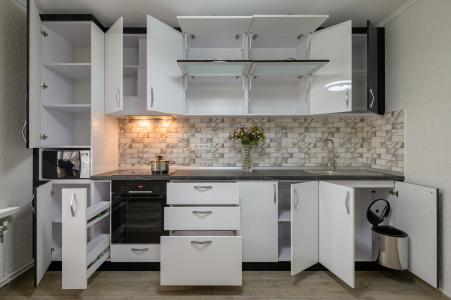
5 Strategies to Make a Kitchen Renovation as Stress-free as Possible
You’ve been planning to remodel your kitchen for months. After countless delays with contractors’ schedules and deliveries of materials and appliances, the start date is finally approaching.
What preparations will make it easier to give up your kitchen temporarily and keep your sanity once the dust starts flying?
1. Pare down.
Whether you’re painting or replacing your cabinets, they must be emptied. Yes, it’s a hassle, but it also offers an ideal opportunity to eliminate clutter. Can you admit that you’ll never use your electric popcorn machine, and it’s time to let it go? Ditto for the banana slicer and the egg cracker?
As you empty your shelves and drawers, be honest about whether an item deserves space in your new kitchen. Then, go ahead and donate things someone else may want, including small appliances, gadgets, utensils, extra glassware, bowls, pots, and pans. Discard any expired food, too.
2. Set up a temporary kitchen.
Before packing the kitchen items you plan to keep, pull out anything used in your daily routines. These are the essentials you’ll want to incorporate into a temporary kitchen.
Assuming you plan to stay in your home while your kitchen is offline, you’ll need to find one or more alternative spaces to prepare food and clean up after meals. A laundry room with a sink can be ideal, but you may need to take a patchwork approach, storing food in one room and preparing it in another.
For example, you could box up items displayed on your living room shelves and temporarily replace them with cooking and serving essentials, plus cereal boxes, canned goods, and other pantry items.
Likewise, a card table tucked into a corner could be a good spot for a coffee maker, a microwave, and a small “countertop” with a cutting board to prepare food.
In addition to a microwave, consider other ways to cook simple meals, like a single-burner cooktop, a toaster oven, or an air fryer.
If your project overlaps with warm weather, take advantage of grilling outdoors. A grill can double as an oven if you use an oven thermometer to monitor its internal temperature.
3. Deal with dishwashing.
Carving out shelf and counter space is one priority. But if your temporary kitchen doesn’t include a sink, you’ll need to find other ways to clean dishes and cooking paraphernalia after meals.
If your kitchen is offline, you have a legitimate excuse to minimize cleanup with disposable plates, cups, and utensils. But it’s not that difficult to get by without a large kitchen sink or a dishwasher, especially with a few simple steps!
First, find two plastic dishpans—one for soapy water and another for clear rinse water—and a drying rack. Set them side-by-side (wash, rinse, dry). Consider arranging your dishpans and drying rack on a shower floor, in a bathtub, or outdoors on a patio table for a waterproof workspace.
Before washing your plates, bowls, and pans, use a paper towel, plastic scraper, or spatula to scrape any leftover food into the trash. Your dishes will wash up twice as fast, and your sudsy water will stay clean.
Lightly scrub each item in the soapy water before dipping it into the rinse water. Let everything air dry in the rack.
Skip the dishpans and use a bathroom or utility sink for small wash-ups. Squirt a little detergent onto a wet sponge, rub the soap over each item, and rinse under the faucet.
4. Organize your boxes.
You probably won’t miss the kitchen items you decide to box up. But if you do, it will be much easier to retrieve something if you organize and label your boxes.
This can be as simple as keeping all similar things together and labeling them “storage containers,” “baking pans,” etc.
Alternately, it might be easier to remember where you used to keep something and organize your boxes accordingly, labeling your boxes “above refrigerator” or “junk drawer.”
Regardless, ensure your labels are easy to see and read after you’ve stacked and stored the boxes. That way, you won’t have to rearrange everything to find the container that holds whatever you need.
5. Prep a game plan for meals.
A new kitchen is a cause to celebrate and make all your favorite recipes! Before that day comes, however, it’s essential to simplify home meals as much as possible.
In the weeks before your project kicks off, try to cook large batches of recipes that freeze well (think stews, chili, and hearty soups). Then, store them in heavy-duty vacuum seal bags that can be defrosted and boiled in water or heated in a microwave later.
In most homes, dinners are the most demanding meal of the day. So, whenever you prepare a dinner from scratch while your kitchen is offline, bump up the servings and make enough food for at least two meals.
Then, instead of storing leftovers in containers, arrange individual servings on clean plates that can be covered, kept in the fridge, and easily reheated in a microwave for another dinner. One round of cooking turns into two rounds of eating!
If you keep meals simple, selecting recipes with limited ingredients that are easy to prepare, you’ll reduce the temptation to eat out during the renovation, which is one of the easiest ways to blow your budget.
Try to add variety, too. That way, even with the limitations of cooking at home, you won’t get bored of eating the same things.
After all, a kitchen remodel takes time and patience. However, with some planning, it’s much easier to endure—or even enjoy—the transition from BEFORE to AFTER.
